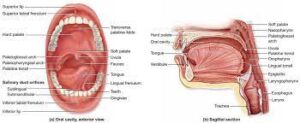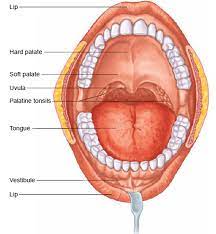

The forward head position (FHP) is an all-too-common issue in today’s digital age.
We see it every day—people hunched over their phones, computers, or tablets, their heads leaning forward and down, creating that telltale “tech neck.”
While we often talk about how this posture affects the neck and shoulders, we rarely hear about the damage it can cause to the pharynx, a crucial part of the throat.
But how does this posture actually harm the pharynx, and why should we be concerned?
I have spent considerable time researching the effects of forward head position and its damaging consequences on your pharynx.
Let me share my findings with you:
In This Article:
- Introduction to Forward Head Position
- What is the Pharynx and Its Function?
- The Link Between Forward Head Position and Pharynx Damage
- How Does Forward Head Position Affect Breathing?
- Impact on Swallowing: Pharynx and Forward Head Position
- Scientific Studies Supporting the Link
- Daily Lifestyle Examples of Forward Head Position
- Conclusion: How Forward Head Position Damages Your Pharynx?
Introduction to Forward Head Position
The forward head position, commonly referred to as “text neck” or “tech neck,” occurs when your head juts forward from your body’s natural alignment.
Instead of being balanced over your shoulders, your head leans forward, putting undue strain on various parts of the body, including the neck, spine, and, less commonly discussed, the pharynx.
This posture can develop from prolonged use of technology, poor ergonomics, or even bad habits like slouching while walking or standing.
While most discussions focus on the musculoskeletal effects, the pharynx, a critical part of the throat, also faces damage from this posture.
The pharynx plays a central role in both respiratory and digestive systems, so its dysfunction can lead to serious health issues.
What is the Pharynx and Its Function?
The pharynx is a muscular tube that connects the nasal and oral cavities to the larynx and esophagus.
Located at the back of the throat, it serves as a pathway for both air and food. It is divided into three regions: the nasopharynx (behind the nasal cavity), the oropharynx (behind the oral cavity), and the laryngopharynx (above the esophagus and larynx).
The pharynx has two main roles:
- Breathing: It helps in the smooth passage of air from the nasal cavity to the lungs.
- Swallowing: It plays a key role in directing food from the mouth to the esophagus, ensuring it does not enter the windpipe.
Any interference with the function of the pharynx can disrupt both breathing and swallowing, leading to various health issues.
The Link Between Forward Head Position and Pharynx Damage
You might wonder, “How can the position of my head affect my throat?”
Well, the forward head position alters the alignment of your neck and upper airway.
When your head is jutted forward, it causes the neck to bend unnaturally, compressing the muscles and structures in the throat area, including the pharynx.
The human body is a well-balanced structure.
The head weighs around 10-12 pounds, and when positioned forward, this weight increases the stress on the neck and throat.
The forward head position can compress the pharynx, making it harder for air to pass through and increasing the likelihood of pharyngeal dysfunction.
Over time, this chronic compression can weaken the pharyngeal muscles, reducing their ability to function properly.
This might not seem like a big deal at first, but when compounded by other lifestyle factors (such as poor breathing habits or binge watching TV), the damage becomes more significant.
How Does Forward Head Position Affect Breathing?
The most immediate effect of a forward head position on the pharynx is the disruption of airflow.
The pharynx is integral to maintaining an open airway, but when the head is tilted forward, it can cause a narrowing of this passage.
This is why individuals with poor posture often find themselves struggling to breathe deeply.
Think of it this way: when your head is jutted forward, the pharynx is pushed into a compressed state, and airflow becomes more restricted.
This can lead to shallow breathing, causing the body to compensate by taking shorter, quicker breaths. Over time, this can lead to conditions like sleep apnea, where breathing becomes irregular during sleep.
A study published in the Journal of Clinical Sleep Medicine found that individuals with poor head and neck posture had a significantly higher risk of developing obstructive sleep apnea due to compromised airflow through the pharynx.
This connection highlights how posture can have far-reaching effects beyond just neck pain.
Impact on Swallowing: Pharynx and Forward Head Position
Swallowing might seem like a simple process, but it actually requires the precise coordination of muscles, including those in the pharynx.
The forward head position can alter this coordination by placing excessive strain on the muscles involved in swallowing.
When your head is tilted forward, the pharynx’s natural alignment is disrupted, making it harder to move food and liquids through the throat efficiently.
This can lead to symptoms like dysphagia (difficulty swallowing), where it feels like food is getting “stuck” in the throat.
Additionally, the compression of the pharynx caused by poor posture can slow down the reflexes involved in swallowing, increasing the risk of aspiration (food entering the airway instead of the esophagus).
In severe cases, this can lead to respiratory infections or even choking.
Scientific Studies Supporting the Link
Several studies support the connection between forward head posture and pharyngeal dysfunction.
A 2014 study in the Journal of Oral Rehabilitation found that individuals with a forward head posture experienced significantly more swallowing difficulties compared to those with normal posture.
The researchers concluded that poor posture led to weakened pharyngeal muscles and disrupted the normal swallowing process.
Moreover, a study published in Respiratory Physiology & Neurobiology indicated that forward head position could lead to narrowing of the upper airway, contributing to breathing issues such as obstructive sleep apnea.
The study highlighted that poor posture reduces the diameter of the pharynx, further proving how critical head positioning is to respiratory health.
These studies emphasize the importance of posture in maintaining both breathing and swallowing functions, two critical roles of the pharynx.
Daily Lifestyle Examples of Forward Head Position
Forward head posture is not just a problem for office workers—it is everywhere in our daily lives.
Here are a few lifestyle examples that demonstrate how common this posture has become:
- Screen Time: Whether it’s checking your phone, binge-watching Netflix, or working on your laptop, most of us are guilty of hunching over screens for hours. This causes the head to lean forward, straining both the neck and pharynx.
- Driving: Long commutes in poorly adjusted car seats can encourage a forward head position, especially if you lean toward the steering wheel.
- Sleeping Posture: Poor pillow support can cause your head to tilt forward while you sleep, adding to the damage done to your pharynx over time.
- Reading: Ever find yourself leaning over a book for too long? This too can lead to chronic forward head posture, affecting your pharynx and overall throat health.
These habits may seem harmless, but over time, they contribute to the chronic issues related to forward head posture, including pharynx damage.
Takeaway
In conclusion, the forward head position does more than just cause neck and back pain—it can significantly damage your pharynx.
This damage occurs due to the unnatural compression and misalignment of the pharyngeal muscles, which play essential roles in both breathing and swallowing.
When your head is consistently tilted forward, your pharynx becomes compressed, reducing its ability to efficiently move air and food.
This can lead to shallow breathing, difficulty swallowing, and even conditions like obstructive sleep apnea.
The link between posture and the pharynx is further supported by scientific studies, which show that poor posture directly contributes to pharyngeal dysfunction.
So, while the forward head position may seem like a minor inconvenience in the short term, its long-term effects on the pharynx can lead to serious health issues.
Paying attention to how you sit, stand, and move throughout the day can help minimize this damage and keep your pharynx functioning properly.
References:

